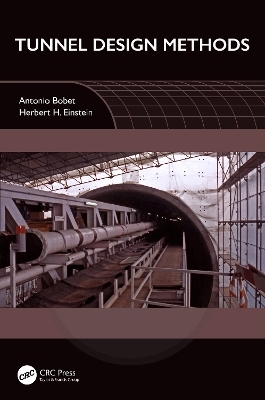
Tunnel Design Methods
Seiten
2023
CRC Press (Verlag)
978-1-032-35844-4 (ISBN)
CRC Press (Verlag)
978-1-032-35844-4 (ISBN)
This covers analytical, numerical and empirical methods for the design of tunnels in soil and in rock. It gives detailed analytical and numerical methods for design engineers, suits graduate students, and guides specialists in ground–support interaction under static and seismic loading.
Tunnel Design Methods covers analytical, numerical, and empirical methods for the design of tunnels in soil and in rock. The material is intended for design engineers looking for detailed methods, for graduate students who are interested in tunnelling, and for researchers working on various aspects of ground-support interaction under static and seismic loading.
The book is divided into seven chapters, covering fundamental concepts on ground and support behavior and on ground-excavation-support interaction and provides detailed information on analytical and numerical methods used for the design of tunnels, with applications, and on the latest developments on empirical methods. The principles and formulations included are used, throughout the book, to provide insight into the response of tunnels under both simple and complex loading conditions, thus providing the reader with fundamental understanding of tunnel behavior.
Both authors have experience in tunnelling and have worked extensively in practice, designing tunnels both in the United States and abroad, and in research.
Tunnel Design Methods covers analytical, numerical, and empirical methods for the design of tunnels in soil and in rock. The material is intended for design engineers looking for detailed methods, for graduate students who are interested in tunnelling, and for researchers working on various aspects of ground-support interaction under static and seismic loading.
The book is divided into seven chapters, covering fundamental concepts on ground and support behavior and on ground-excavation-support interaction and provides detailed information on analytical and numerical methods used for the design of tunnels, with applications, and on the latest developments on empirical methods. The principles and formulations included are used, throughout the book, to provide insight into the response of tunnels under both simple and complex loading conditions, thus providing the reader with fundamental understanding of tunnel behavior.
Both authors have experience in tunnelling and have worked extensively in practice, designing tunnels both in the United States and abroad, and in research.
Antonio Bobet is a professor at Purdue University, USA who has previously worked in industry and is a specialist in the seismic design of tunnels and ground-tunnel interaction. Herbert H. Einstein is a professor at MIT, USA. He has developed the widely used Schwartz–Einstein method and the Decision Aids for Tunnelling, a computer based interactive tool, and works on the use of AI and Machine Learning in tunnelling.
1. Principles of Ground-Structure Interaction. 2. Empirical Methods and Classifications for Rock Tunnels. 3. Direct and Indirect Methods for Soil Tunnels: with Effects on the Surface. 4. Analytical Methods. 5. Numerical Methods. 6. Special Cases. 7. Analysis of Structural Components.
| Erscheinungsdatum | 14.09.2023 |
|---|---|
| Zusatzinfo | 48 Tables, black and white; 16 Line drawings, color; 363 Line drawings, black and white; 13 Halftones, color; 29 Illustrations, color; 363 Illustrations, black and white |
| Verlagsort | London |
| Sprache | englisch |
| Maße | 178 x 254 mm |
| Gewicht | 1500 g |
| Themenwelt | Naturwissenschaften ► Geowissenschaften ► Geologie |
| Naturwissenschaften ► Geowissenschaften ► Geophysik | |
| Technik ► Bauwesen | |
| Technik ► Umwelttechnik / Biotechnologie | |
| ISBN-10 | 1-032-35844-0 / 1032358440 |
| ISBN-13 | 978-1-032-35844-4 / 9781032358444 |
| Zustand | Neuware |
| Haben Sie eine Frage zum Produkt? |
Mehr entdecken
aus dem Bereich
aus dem Bereich


